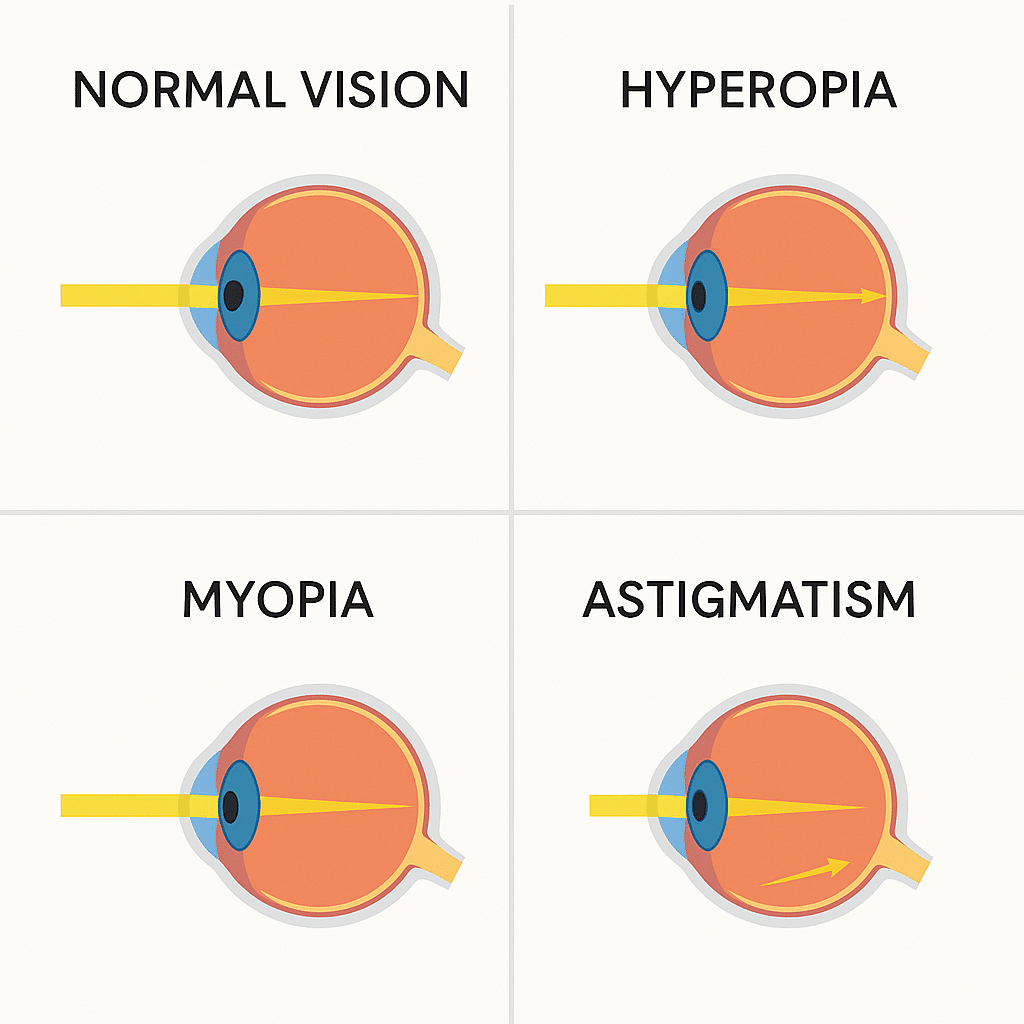Nearly 50% of the global population will develop myopia by 2050. About 10% will have high myopia that goes beyond -6.00 diopters. Laser eye surgery high prescription options give people with severe myopia or hyperopia (farsightedness) a chance to live without glasses and contacts.
Many people think their prescriptions are too extreme to fix. Modern technology has expanded treatment options by a lot. High myopia means prescriptions of -6.00 diopters or more. Hyperopia ranges from mild (+3.0 diopters) to severe (over +6.0 diopters). FDA approval now covers LASIK procedures up to -12.00 diopters for nearsightedness and +6.00 diopters for farsightedness. Traditional laser eye surgery has its limits. That’s why doctors developed alternative procedures like Implantable Collamer Lens (ICL) and Refractive Lens Exchange (RLE) to help people with very high prescriptions.
Let’s explore your options for high prescription laser eye surgery and find what works best for your vision. You’ll learn about eligibility requirements, recovery time, and long-term results to help you make the right choice about your vision correction experience.
Understanding High Prescription Refractive Errors

Light fails to focus correctly on the retina when your eye’s shape isn’t quite right. This creates refractive errors. You need to understand these conditions before you start learning about laser eye surgery options for extreme prescriptions.
What qualifies as high myopia and hyperopia?
Doctors call severe nearsightedness “myopia magna” or “pathological myopia.” These terms describe prescriptions of -6.00 diopters or stronger . Your eyeball stretches too much in this condition, which makes distant objects look blurry. About 10% of people with myopia have this severe form, and they face higher risks of retinal degeneration and detachment .
High hyperopia means severe farsightedness with prescriptions of +6.00 diopters or higher . This condition isn’t as common as myopia and shows up in only 5-10% of people . It can make your vision blurry at any distance, not just up close.
How eye shape affects light refraction
Your eye’s anatomical structure determines how light focuses on your retina. Light waves join perfectly on the retina in a normal eye. A typical adult’s eyeball measures about 24.2mm from top to bottom and 23.7mm from side to side .
Myopic eyes stretch too long from front to back, so light focuses in front of the retina . MRI studies show that highly myopic eyes have a “prolate” shape—they curve more at the posterior pole than around the edges .
Hyperopic eyes tell a different story. These eyes are too short, or their corneas are too flat, which makes light focus behind the retina . They take on an “oblate” shape. Research reveals hyperopic eyes have a volume of about 6,370 cubic millimeters, while myopic eyes are bigger at 7,240 cubic millimeters .
Differences between hyperopia and presbyopia
Near objects look blurry in both conditions, but hyperopia and presbyopia happen for completely different reasons. Hyperopia comes from your eyeball’s shape—it’s either too short or doesn’t curve enough at the cornea .
Age brings presbyopia naturally, usually after 40, as your eye’s lens becomes stiff and loses its flexibility . Unlike hyperopia, which can exist from birth, presbyopia only happens because of aging .
Some people deal with both conditions at once, and each needs its own fix. Presbyopia makes close-up vision difficult, while severe hyperopia can blur your vision at any distance .
Laser Eye Surgery Options for Severe Prescriptions
| Feature / Step | PRK (1st Gen) | LASIK (2nd Gen) | SMILE (3rd Gen) |
|---|---|---|---|
| Surgical Approach | Surface ablation | Flap-based surgery | Keyhole/lenticule extraction |
| Tissue Access | Epithelium removed | Corneal flap created and lifted | Small incision in cornea |
| Laser Used | Excimer laser | Excimer + Femtosecond (for flap) | Femtosecond laser only |
| Recovery Time | Longer (days to weeks) | Fast (1–2 days) | Very fast (1–2 days) |
| Pain/Discomfort | Moderate to high | Low | Very low |
| Risk of Flap Issues | None | Present | None |
| Corneal Strength | Preserved, good for thin corneas | Reduced (due to flap) | Preserved |
| Suitability | Thin corneas, active lifestyles | Wide range of prescriptions | Mild to moderate myopia/astigmatism |
| Complexity | Simple | Moderate | High |
Modern laser eye surgery gives patients multiple options to correct severe vision problems. Recent advances in these procedures help patients with extreme prescriptions who couldn’t get treatment before.
LASIK for high myopia and hyperopia
LASIK stands as the most popular laser vision correction procedure and works well for high prescriptions within certain limits. LASIK corrects nearsightedness up to -12.00 diopters, while farsightedness corrections reach +4.00 to +6.00 diopters . Astigmatism corrections can go up to 6.00 diopters .
Surgeons create a thin flap in the cornea’s surface and reshape the tissue beneath with an excimer laser. Higher prescriptions need more corneal tissue removal, so patients must have thick enough corneas to support both the flap creation and tissue removal . Wavefront-guided LASIK technology offers better precision that lets surgeons treat higher prescriptions traditional methods don’t deal very well with . Most patients can drive within 1-2 days after surgery .
PRK and LASEK for thin corneas
PRK (Photorefractive Keratectomy) and LASEK (Laser Epithelial Keratomileusis) work well for patients with thin corneas who can’t get LASIK. These surface treatments remove the corneal epithelium completely before laser reshaping .
Recovery takes longer than LASIK—patients need 1-4 weeks to drive safely . All the same, visual outcomes ended up being similar . These procedures work best for patients with irregularly shaped corneas or chronic dry eyes .
SMILE procedure for minimal tissue removal
SMILE (Small Incision Lenticule Extraction) brings new laser vision technology that helps patients with high prescriptions. SMILE uses a tiny incision (less than 4mm) to remove a pre-determined piece of corneal tissue instead of creating a flap.
This gentle approach treats myopia between -1 and -10 diopters and astigmatism up to 3 diopters in FDA-approved settings . Some platforms can correct astigmatism up to 6 diopters . Studies show that 99% of patients achieve at least 20/40 vision, and 88% reach 20/20 vision .
SMILE keeps more corneal nerves intact and reduces dry eye symptoms . The procedure also maintains stronger corneal biomechanical stability than flap-based surgeries, making it ideal for patients with thinner corneas .
Alternatives to Laser Surgery for Very High Prescriptions
Patients with very high refractive errors often can’t get enough correction from traditional laser procedures. These alternative surgical options provide solutions if your prescription goes beyond laser eye surgery limits.
Implantable Collamer Lens (ICL) for high myopia
ICL surgery places a biocompatible collamer lens inside the eye, between the natural lens and the iris, without removing corneal tissue. This reversible procedure can correct myopia up to -20.00 diopters . Patients with severe nearsightedness beyond LASIK’s capabilities benefit greatly from this option.
ICL shows impressive outcomes in studies. A large study revealed that 96% of patients with high myopia achieved 20/40 vision or better after ICL implantation . The procedure works great for people with thin corneas or dry eyes because it preserves corneal structure .
The newer EVO-ICL model comes with a central hole design that eliminates the need for preoperative iridotomy and reduces cataract formation risk . Patients often see better than they did with eyeglasses due to image magnification effects. High myopia patients gained an average of 1.51 lines of vision compared to their previous best-corrected vision .
Refractive Lens Exchange (RLE) for hyperopia
RLE replaces the eye’s natural lens with an artificial intraocular lens (IOL), similar to cataract surgery but performed on clear lenses . We found it beneficial for hyperopia as it effectively addresses prescriptions that go beyond laser surgery limits .
The procedure shows excellent results – 95% of patients achieve driving-standard vision or better . On top of that, it permanently prevents future cataracts since the natural lens gets removed completely .
RLE works best for patients aged 50+ or those with very high farsightedness. Recovery takes 3-4 days. Patients experience temporary blurred vision and mild discomfort at first .
When glasses or contacts are still recommended
Advanced surgical options exist, but traditional corrective eyewear remains appropriate in certain cases. Patients with unstable prescriptions, certain corneal conditions, or those under 18 should stick with glasses or contacts .
People with severe dry eye syndrome, autoimmune disorders, or certain retinal conditions face higher surgical risks. Non-surgical options prove safer for them . Some patients with prescriptions higher than -20D might need specialty contact lenses or glasses if they don’t qualify for any surgical procedure.
Suitability, Risks, and Recovery Considerations
Several factors determine if someone qualifies for high prescription corrections. Doctors need to look at both eye measurements and overall health to decide if a patient is suitable.
Laser eye surgery prescription limits by procedure
The FDA has approved LASIK for corrections up to -12.00D of myopia, +6.00D of hyperopia, and 6.00D of astigmatism . Most clinics play it safer with their limits:
- LASIK: Treats myopia between -0.5D to -8.0D and hyperopia up to +4.0D
- PRK/LASEK: Works better for thin corneas and can sometimes handle higher prescriptions than LASIK
- SMILE: Treats myopia between -1.0D to -10.0D with astigmatism up to 3.0D
This means many patients who weren’t good candidates before can now find surgery options that work for them.
Corneal thickness and eye health requirements
Corneal thickness plays a crucial role in safety, especially when you have high prescriptions. LASIK patients need a residual stromal bed of at least 250 microns after surgery . Thinner flaps (74-75 microns instead of the usual 110-120 microns) can make LASIK possible for some borderline cases .
Good candidates must have:
- A prescription that hasn’t changed for at least two years
- Eyes free from diseases or infections
- No autoimmune disorders or immunosuppressive conditions
Recovery timelines for LASIK, PRK, and SMILE
Each procedure has its own recovery pattern:
LASIK and SMILE patients usually get back to functional vision within 24-48 hours . PRK takes longer – about 3-5 days for the corneal epithelium to grow back. During this time, vision stays blurry and patients feel some discomfort .
Vision takes time to fully stabilise. Clinical data shows LASIK stabilises in 1-2 months, while PRK needs about 3 months for complete healing .
Potential side effects and long-term risks
Most patients experience temporary effects like dry eyes, sensitivity to light, and night vision issues such as halos or starbursts .
Serious complications are rare but can include:
- Under/overcorrections (affecting 8.15% of high prescription patients)
- Prescription changes, more common with very high prescriptions
- Corneal ectasia if the remaining stromal bed is too thin
- Flap complications (seen in 2.12% of cases)
Long-term studies bring good news – even extreme prescriptions show great success rates. The safety index (comparing vision before and after surgery) reaches 1.17 for patients with thin corneas after surgery .
Conclusion
Vision correction technology has transformed treatment options for extreme prescriptions. Modern surgical approaches now help patients with high myopia (beyond -6.00 diopters) and severe hyperopia (exceeding +6.00 diopters). Traditional LASIK treatments cover a wider range now, and newer techniques like SMILE work better for patients with thinner corneas.
Implantable Collamer Lens and Refractive Lens Exchange are great options for prescriptions that doctors once considered uncorrectable. The success rates are impressive – 96% of ICL patients achieve 20/40 vision or better, and 95% of RLE patients can see well enough to drive.
A patient’s eligibility depends on more than just prescription strength. Corneal thickness, eye health, stable prescriptions, and the absence of certain medical conditions are vital factors that determine suitable candidates. Recovery times vary between procedures, but most patients can see well enough to function within days.
Some patients experience temporary dry eyes and night vision issues, but the largest longitudinal study confirms these procedures are safe and work well. The rise of refractive surgery means patients with severe vision problems have more treatment choices than ever. Are you dealing with a high prescription? You can find safe and budget-friendly laser eye surgery options that work for severe myopia and hyperopia. Book your expert consultation at Precision Vision London today!
The risks exist, but they pale in comparison to the life-changing benefits of reducing dependence on thick glasses or contact lenses. A complete consultation with experienced specialists helps you make the right choice. Whatever procedure you choose, today’s advanced technologies offer hope and clear vision to people who were once told their prescriptions were too severe for surgery.
FAQs
Q1. What are the options for laser eye surgery with high myopia? For high myopia up to -12.00 diopters, LASIK is typically an option. For prescriptions beyond that, alternatives like Implantable Collamer Lens (ICL) can correct myopia up to -20.00 diopters. The best option depends on individual factors like corneal thickness and overall eye health.
Q2. Can LASIK correct very high prescriptions? LASIK can generally correct nearsightedness up to -12.00 diopters and farsightedness up to +6.00 diopters. However, most clinics set more conservative limits. For prescriptions beyond these ranges, alternative procedures like ICL or Refractive Lens Exchange may be recommended.
Q3. What is the recovery time for different laser eye surgery procedures? Recovery times vary by procedure. LASIK and SMILE patients often achieve functional vision within 24-48 hours. PRK requires 3-5 days for initial recovery as the corneal epithelium regrows. Complete visual stabilisation can take 1-3 months, depending on the specific procedure.
Q4. Are there alternatives for extremely high prescriptions that exceed laser surgery limits? Yes, alternatives exist for very high prescriptions. Implantable Collamer Lens (ICL) can correct myopia up to -20.00 diopters, while Refractive Lens Exchange (RLE) is effective for extreme hyperopia. These options are particularly useful when laser surgery is not suitable.
Q5. What are the potential risks of high prescription laser eye surgery? While generally safe, potential risks include temporary dry eyes, light sensitivity, and night vision disturbances. More serious but rare complications can include under or overcorrections, regression (especially in very high prescriptions), and corneal ectasia. Long-term studies show high success rates, but a thorough consultation with a specialist is crucial to assess individual risk factors.
Authors & Reviewer
-
 Olivia: Author
Olivia: AuthorHi, I'm Olivia, a passionate writer specialising in eye care, vision health, and the latest advancements in optometry. I strive to craft informative and engaging articles that help readers make informed decisions about their eye health. With a keen eye for detail and a commitment to delivering accurate, research-backed content, I aim to educate and inspire through every piece I write.
-
 Dr. CT Pillai: Reviewer
Dr. CT Pillai: ReviewerDr. CT Pillai is a globally recognised ophthalmologist with over 30 years of experience, specialising in refractive surgery and general ophthalmology. Renowned for performing over 50,000 successful laser procedures.

